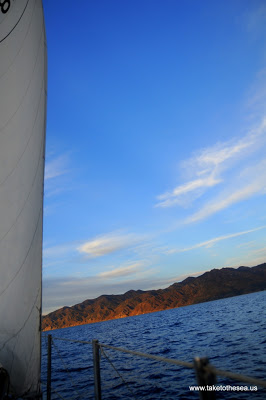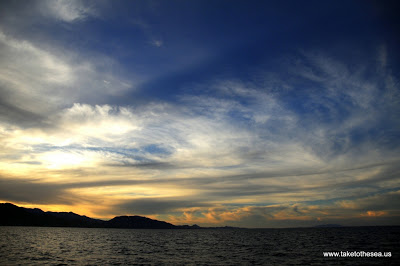 Close reach with Isla Cerralvo on our starboard side.
Close reach with Isla Cerralvo on our starboard side.
Log Book
- Departure time: 12:30pm on Thursday, January 10
- Arrival time: 2:30am on Friday, January 11
- Total travel time: 14 hours
- Nautical miles travelled: 61.3nm
- Engine hours start – end – logged: 957.3 – 967 – 9.7
- Gallons of diesel start – end – used: 23.2 – 19.3 – 3.9
- Weather: The forecast predicted light and variable winds, 0-5 knots, with 0-1 foot wind waves.
Wary of going back out with big square waves on our bow, we
waited in Bay of the Dead (Bahia de los Muertos) for the wind and seas to tire
themselves out. On this passage we would be transiting Cerralvo Channel (Canal
Cerralvo) as well as Saint Lorenzo Channel (Canal San Lorenzo), both of which
are known for stronger wind and current given the local topography. Both
channels funnel wind and water, which can mean not so awesome (and potentially
dangerous) conditions, especially in the notoriously narrow San Lorenzo Channel
(constrained by shoals and reefs). A ferry boat from La Paz was sunk in the San
Lorenzo channel after impaling itself on the reef. The current at any given point
can be 3+ knots against you and wind pushing against the current can create
steep waves. Window Bay (Bahia la Ventana), which lies opposite of Cerralvo
Island is a world renowned windsurfing spot due to the somewhat reliable wind created
by the mountains that guard it from the West and the island that snuggles up to
it from the East.
The strong ebb current was slated to begin at 9am and pull
water to the ocean until about 3pm when the flood would commence. The flood
would carry us northward until around 10pm when another small ebb would start.
We wanted to hit the St. Lorenzo Channel, which was approximately 44 miles away, at the slack
tide following the flood. We would then have a very small current (probably 0.5
knots) for the duration of our trip into La Paz.
We intended to leave at around 11:30, but just as we were
cleaning up the decks the Mexican navy started making its rounds in the Bay.
They had been anchored behind our boat for the previous two evenings, but chose
this morning to pay us a visit. Two of the officials boarded our boat while the
other two waited in the dinghy. We supplied multiple pieces of paper, not entirely
sure what they needed or wanted. After looking at our title, registration,
temporary import permit, and crew list (stamped and signed by the officials in
Ensenada), they asked if we had another piece of paper that had our vessel name
along with the hull identification number (HIN) and our names. We were unable
to unearth anything on our boat that had all of this information in one place.
He then asked to see where the HIN was imprinted on our boat. Since our boat is
a one-of-a-kind, it doesn’t have a manufacturer’s HIN and we never got around
to engraving the state-issued HIN. After some hesitation he told us it was
fine, but that we should really get around to putting it on our boat – on the
transom and somewhere inside. To which we replied “Por supuesto (of course).”
Add it to the ever growing list of boat projects to do in La Paz.
We pulled up anchor and went on our way at 12:30. The
forecast predicted light and variable winds in the 0-5 knot range with tame
seas. The prediction was mostly correct until we turned the corner into the
Cerralvo Channel. We were getting a solid 13 knots from the N/NW, but
fortunately the seas were still somewhat calm. We raised the mainsail and genoa
and were moving along (even against the current) at 5 knots.
It was a lovely day for sailing and we sailed for the
majority of the afternoon. As evening approached the wind died down and shifted
more to the West, allowing us to follow a better, more direct angle to San
Lorenzo Channel. We were inching along at 3 knots when Jeff decided to grab a
nap (we still had several hours ahead of us).
“When do you want to start up the engine?” He inquired.
“Oh, I don’t know…when
we get down to about 2 knots or so?”
“Sounds like a plan.”
Within moments we were hovering right around 1.7 knots. We
pulled down the sails and kicked on the motor and were pleased to see that with
the aid of the current we were making anywhere from 5.6 to 6 knots. After a two
hour nap Jeff switched positions with me so I could get a little rest. We both
planned to be on deck and alert when we got to the channel.
 Beautiful calm evening.
Beautiful calm evening.
With the aid of our trusty Navionics charts, our handheld
GPS and paper charts we navigated safely through the narrow channel at slack
tide. We saw only one light in the channel – the green marker. According to our
charts there was also supposed to be a red light, but we couldn’t spot it (Jeff
mentioned something about it possibly getting lost in a recent storm and never
being replaced). There were also white blinking markers on the reef to our
starboard side and on the point to our port side.
The rest of the trip was entirely uneventful (the best kind
when it’s 1:00 am in the morning, you’re a bit sleepy and you’re entering a
new, unknown, port. The La Paz channel is nearly miles long and it’s hard not to
get anxious because when you enter the channel you still have about 45 minutes to an hour until
you can actually drop the anchor.
We arrived at 2:30am and dropped our hook just outside of
the channel near the municipal pier (we later came to find out we were a bit
too close to the pier and needed to uproot and move). Jeff turned the VHF to
channel 22a, which is the channel that all the cruisers use to hail each other
and also to transmit the morning “radio nets” where cruisers exchange
information about weather, tides, emergencies, lost and found, gear trades,
etc. The radio net, which starts at 8:00am, was our alarm clock the next morning.
When the MC asked for arrivals or departures I scrambled out of bed in my
undies and called in to tell the fleet that we had arrived in the middle of the
night. It felt good to say it aloud to a community who knows what that means…to
arrive, after many miles of joyful discovery and turbulent tribulations. Hemos llegado
– we have arrived.